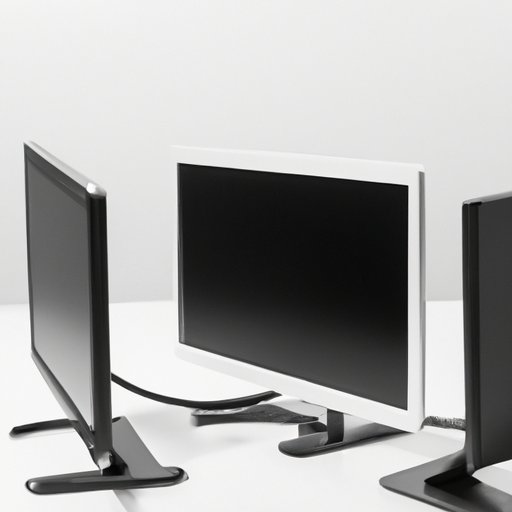
How to Connect Monitor to Laptop: A Step-by-Step Guide
If you are looking to increase your productivity, improve your visual experience, or simply expand your laptop’s display, connecting your laptop to a monitor can be an excellent solution. While the process may seem daunting, it is quite easy and can be accomplished in just a few simple steps. This article will provide a step-by-step guide on how to connect your laptop to a monitor using different connectivity options, tips for troubleshooting, and guidelines for considering specialty monitors.
Step-by-Step Guide
Before we begin, you will need a few things to get started:
- A monitor
- A laptop
- A cable that matches your monitor’s input and your laptop’s output
- If your laptop does not have a VGA or HDMI port, you may need an adapter or docking station
The following steps outline how to connect your monitor to your laptop:
- Turn off both your laptop and monitor.
- Locate the input/output ports on your monitor and laptop.
- For HDMI, it will look like a thin, wide, 19-pin connector, usually labeled as HDMI.
- For VGA, it will be a trapezoidal 15-pin connector, usually labeled as VGA.
- For DVI, it will be a white connector with numerous small square pins, usually labeled as DVI.
- For USB-C, it will be a small, reversible oval port.
- Connect one end of the cable to your laptop and the other end to your monitor.
- Turn on your laptop and monitor.
- On your laptop, go to “Settings” and select “Display Settings.”
- Depending on your laptop and operating system, the steps may vary, but you can typically access display settings by right-clicking on your desktop and selecting “Display Settings.”
- Choose the option to “Extend your display.”
- This enables you to use both your laptop’s display and the external monitor.
- Adjust the monitor’s orientation, resolution, and other settings to your preference.
For a better understanding of these steps, you can refer to the following video:
Different Connectivity Options
The following are the most common connectivity options available:
- HDMI – High-Definition Multimedia Interface
- VGA – Video Graphics Array
- DVI – Digital Visual Interface
- USB-C – Universal Serial Bus Type C
The HDMI option provides better quality audio and video. VGA is less common nowadays but still used in some older displays. DVI is also becoming less common due to new ports. USB-C is the newest port and can support fast charging, data transfer, and video output.
Each connection option has its own benefits. HDMI, for example, offers better image and sound quality. VGA can be cheaper and more compatible with older monitors. USB-C is often convenient for those who travel frequently and need a portable solution. DVI is faster and offers higher resolutions.
Troubleshooting Guide
Even with all the available connectivity options, sometimes things can go wrong when connecting your laptop to your monitor. Here are some common issues and their solutions:
- Monitor not detected: Restart everything and check the cables. Ensure that the input and output cables are connected correctly.
- Display isn’t working as intended: Check that you’re using the correct display settings and adjust as needed. Ensure that the monitor is set to the correct input source.
- Image quality is poor: Check if the cable connecting the monitor and laptop is faulty.
- No sound: Check if your monitor’s speakers are on, and make sure that your laptop audio isn’t muted.
- Resolution is incorrect: Change your laptop’s resolution settings. Match the laptop’s resolution setting to your monitor’s resolution for the best image quality.
In case you run into unexpected issues, don’t hesitate to look through the troubleshooting section of your laptop and monitor’s manuals.
Dual-Monitor Setup
If you’re looking for advanced multitasking capabilities, a dual-monitor setup might be the right choice for you. When you connect a second monitor, it extends your desktop, allowing you to run multiple apps simultaneously. Here’s how to set it up:
- Make sure your laptop has two available video output ports
- Get a suitable cable for your monitor’s input to your laptop’s output.
- Connect the cable to your laptop and the first monitor. Configure your display settings on the first monitor.
- Connect the second monitor to the second output port of your laptop using another appropriate cable. Adjust its orientation and other display settings as desired.
- Choose how you would like to use the dual monitors.
- Extend Screen – You can drag and drop applications from your first monitor to your second monitor.
- Duplicate Screen – Both your monitors will show the same output.
Maximizing your productivity is easier with dual monitors. Here is a video visual aid:
Connecting Specialty Monitors
Some professions require more specialized displays than what might be found in a standard monitor. Photography and video editing, for example, require more significant enhancements to color accuracy and resolution. These will go beyond the traditional display connections we have discussed above.
One option is Thunderbolt ports that allow for extremely fast data transfer speeds and with fast charging capabilities. Another one is the DisplayPort, which transfers high-quality audio, video, and data signals over a single cable. If you’re dealing with 3D graphics, DVI-D Dual-Link ports can support high-resolution outputs. Ensuring that your computer and monitor configuration meets the required technical specifications is paramount.
Conclusion
Connecting your monitor to your laptop is straightforward and improves your visual and productive experience. With this guide in mind, you have learned different connectivity options, step-by-step instructions, tips for troubleshooting, how to use multiple monitors to enhance your workflow, and even what to do if you have more specialized needs.





